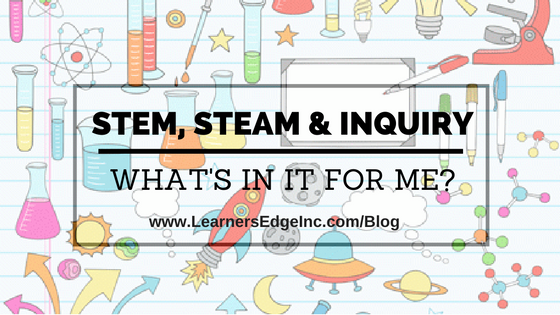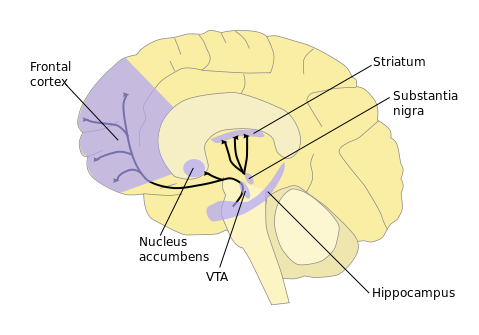
This week’s blog post-co-writer, Nancy Lindfors, currently serves as the Manager of Evaluation and Degree Programs at Learners Edge. Nancy has experience in K-12 education as a Middle and High School science teacher and has worked in Faculty Development and Academic Affairs in Higher Education as well as Community Education and Corporate Training and Development.
This week’s blog post-co-writer, Barb Istas, is currently a Learners Edge Curriculum and Instruction Specialist. Prior to joining Learners Edge, Barb was a language arts teacher for 25 years in a large suburban Minnesota school district where she integrated the arts into her daily classroom instruction.
STEM, STEAM, and Inquiry- What’s in It for Me?
The goal of education is not to increase the amount of knowledge but to create the possibilities for a child to invent and discover, to create [people] who are capable of doing new things. ~ Jean Piaget
Google “student-centered learning” and you’ll get over 3 million hits! Teachers across the country are working tirelessly to create engaging and relevant learning experiences for their students. The shift toward STEM and STEAM with a focus on inquiry learning is in high gear! Many educators believe these strategies will deepen student understanding, improve academic performance, and prepare students with 21st Century Skills needed in tomorrow’s workforce. The brain science is clear; but we’d like to focus in on another compelling factor to this equation – teacher engagement and passion! How can STEM, STEAM and Inquiry help to recharge your battery and benefit you as a “lead thinker” in your classroom? Find your flow zone!
Have you ever experienced that holy grail of teaching- you know the one; time flies by and even the students are surprised when the day or hour comes to a close? It’s that “zone” or “flow,” asit is sometimes called – the mental state of operation in which you are so immersed, so engaged and focused, that you get lost in the enjoyment of the process or activity. It’s that special place between boredom and frustration. It requires time and skill, and won’t be easy, but the benefits are worth the investment.
students to ask the right questions. And studies show it’s working. Decades of research reveal there are many benefits to empowering students via learner-centered education strategies like Inquiry, STEM, and STEAM. They can include:
- increased motivation for learning
- greater satisfaction with school
- personal involvement
- intrinsic motivation
- personal commitment
- confidence in one’s abilities to succeed
- a perception of control over learning leading to more learning
- and higher achievement in school
Imagine a classroom full of motivated students who like school and are intrinsically motivated and confident in their ability to succeed. We would argue that many of the benefits listed above will also ring true for you. How do you think an empowered, engaged and intrinsically-motivated student body affects your motivation and attitude toward school?
3. We learn best in context. Integrated STEM and STEAM lessons connect concepts from several disciplines starting with a “whole” instead of the pieces provided when concepts are broken down by subject.
Once the brain has stored basic curriculum concepts, the storing-by-association system of the brain attaches new information to those basic concepts, building new ones as students have learning experiences that involve them in integrated subject matter. ~ Laster
An integrated instructional approach can help students relate authentic concepts to the real world. Students can therefore connect ideas to something about which they already have thoughts and feelings. Integrating content allows students to “see” relationships between what they already know and the new branches they can grow to create new models. Content in context to bigger picture ideas helps diverse learners express their strengths in a myriad of ways, and allows us to repeat and reinforce key concepts through the web-like connections we help students create.
It’s good for our students- yes! but what does it do for you? For experienced teachers, it can provide a fresh lens through which to view the same core concepts. And it can help to address the pressure all teachers feel to cover all content in a limited time. We can cluster standards – find common ideas and redundancies across disciplines and around which integrated units can be created. In this way, we can explore more standards with fewer units. This can reduce that frenetic race to “get it all in.” Cheers to less stress!
4. The brain is a social organ. In fact, the strongest predictor of a species’ brain size is the size of its social group. We have big brains in order to socialize. Inquiry, STEM and STEAM approaches open the door for students to collaborate and work in groups, but it also requires that we as teachers work collaboratively as we integrate lessons.
Many teachers are trained in specific content areas. When you think of your experience as a student and your experience as a teacher, what comes to mind? Is it a traditional classroom with one teacher, door shut, working in isolation? Through collaboration, teachers are exposed to new ideas, new pedagogical practices, and opportunities to share and support one another. In one study (Waggoner Road Junior High and Baldwin Road Junior High in Reynoldsburg, Ohio) students experienced a 20 percent increase in math scores when teachers participated in constant collaboration. And in another study of over 9000 teachers, collaboration resulted in direct improvements in student gains, “Instructional teams engaged in better collaboration also have higher achievement gains in math and reading.” When students win, we win!
But it goes even deeper. Collaborating with teacher colleagues promotes relationships. Let’s face it- teaching can be emotionally draining at times, and we need a support system with whom we can bond, seek advice, and celebrate successes.
5.Integrating the arts enhances both teaching and learning. You can see and feel heightened energy and enthusiasm.

Learners Edge FREE on-demand webinar.

Sources:
- Ronfeldt, M., Farmer, S., McQueen, K., & Grissom, J. (2015). Teacher collaboration in instructional teams and student achievement. American Educational Research Journal, 52(3), 475-514.
- “Attitudinal Factors of Teachers Regarding Arts Integration” Sara Elston Williams, University of Southern Mississippi, pg. 11. (2013)
- Bunzeck et al.: “Absolute Coding of Stimulus Novelty in the Human Substantia Nigra/VTA.” Publishing in Neuron 51, 369–379, August 3, 2006 DOI 10.1016/j.neuron.2006.06.021 www.neuron.org
- Teach the Way the Brain Learns: Curriculum Themes Build Neuron Networks, Madlon T. Laster Rowman & Littlefield Education, 2009.
Learners Edge is passionately committed to providing you with continuing education coursework, materials, and tools that will help you succeed in your classroom and in your career.
Offering more than 100 print-based or online courses for teachers, you can earn the graduate credit you need for salary advancement and meet your professional development needs. Contact us today to get started!







